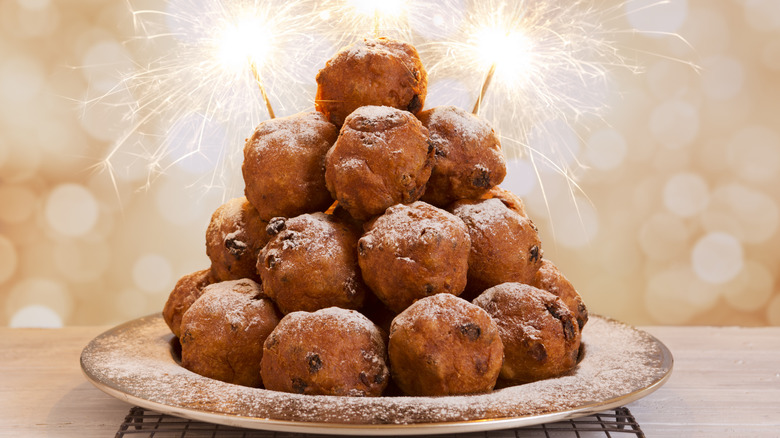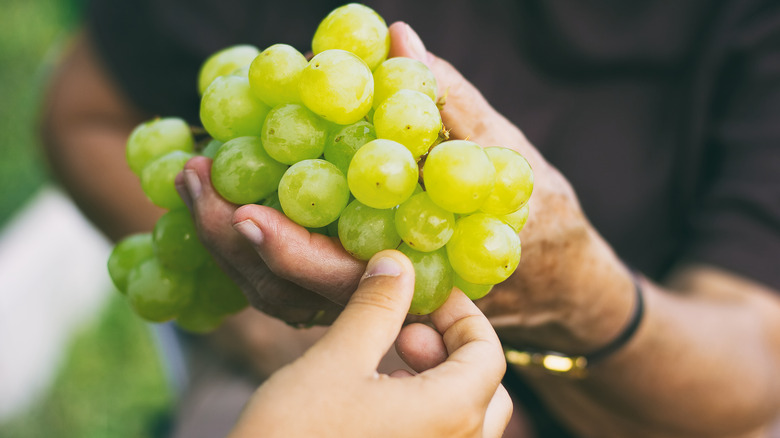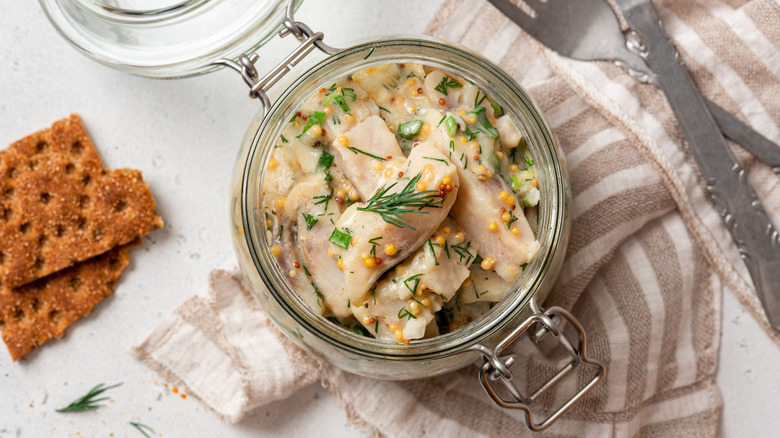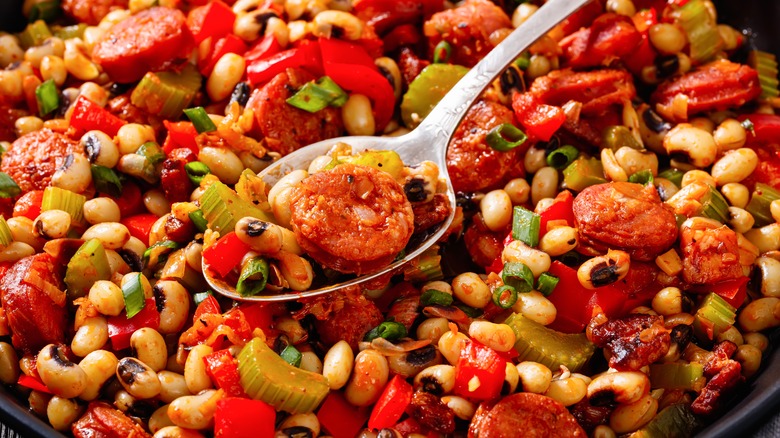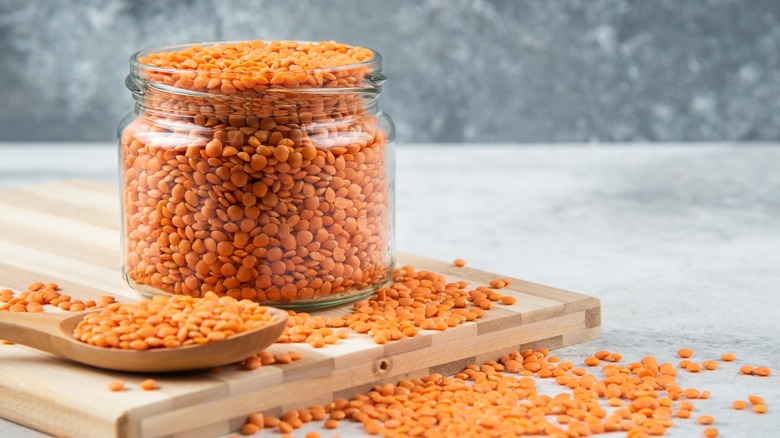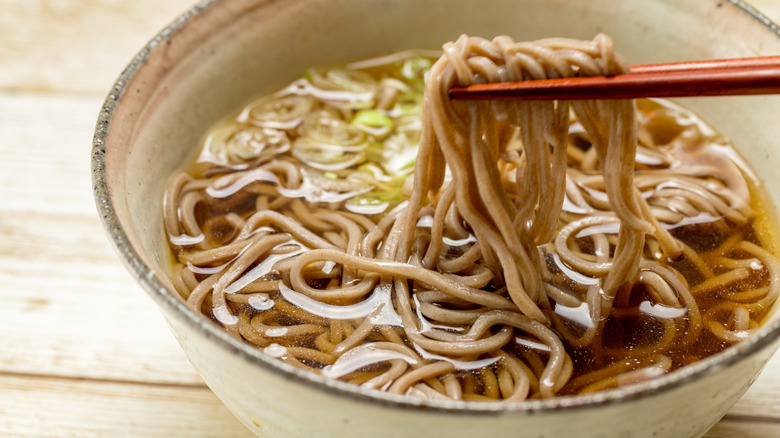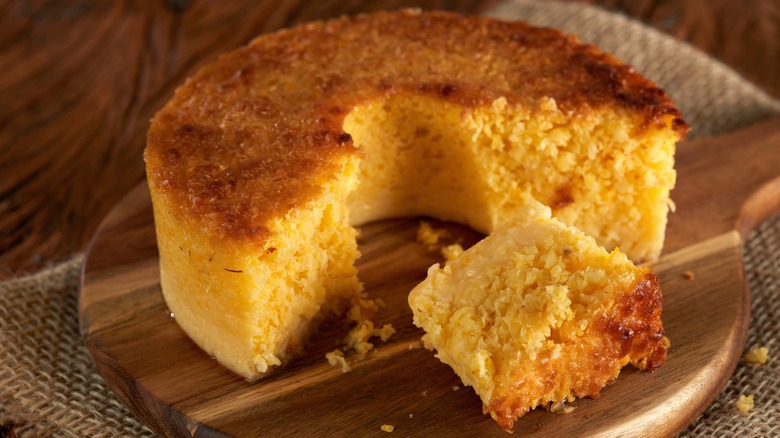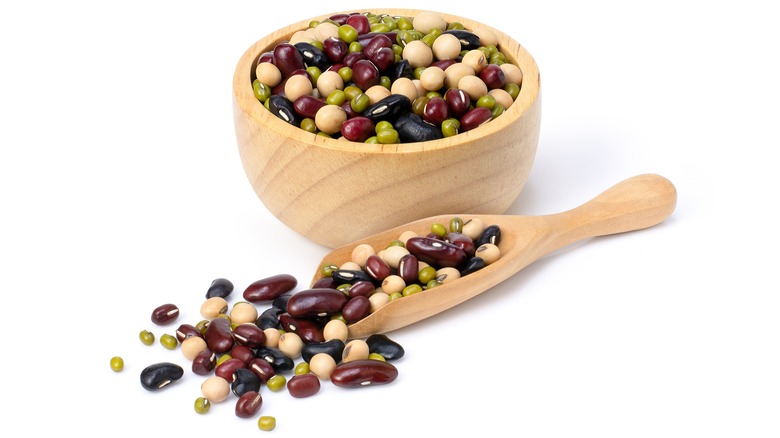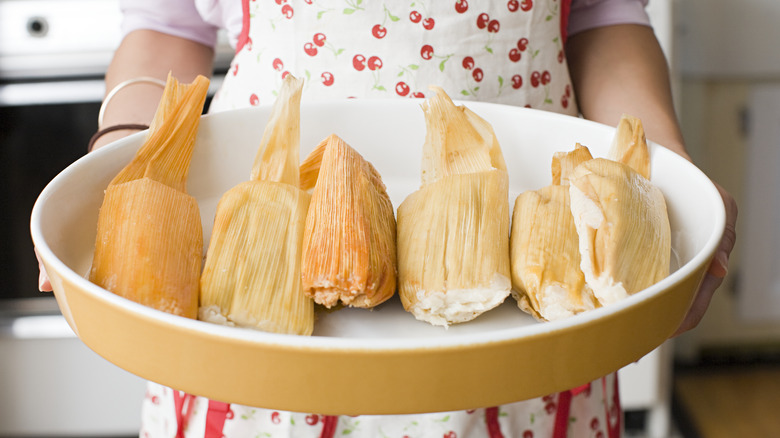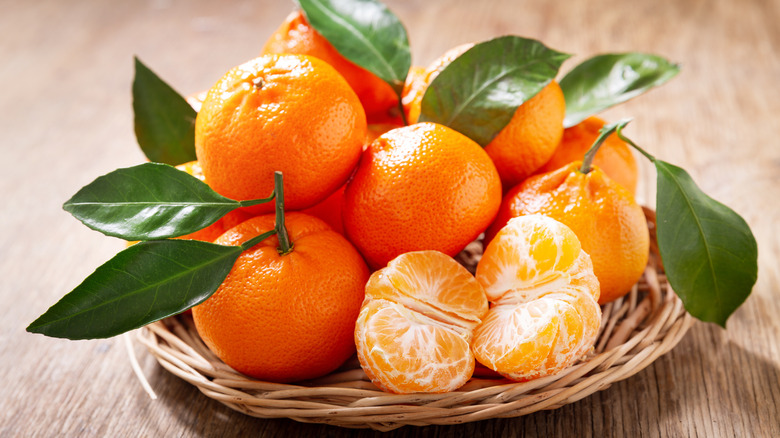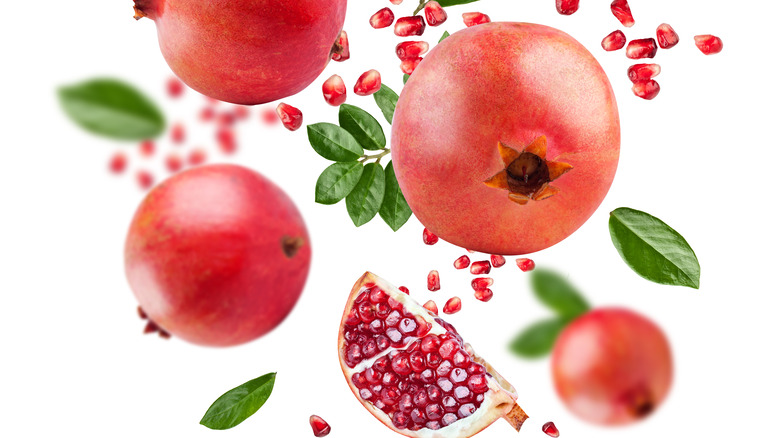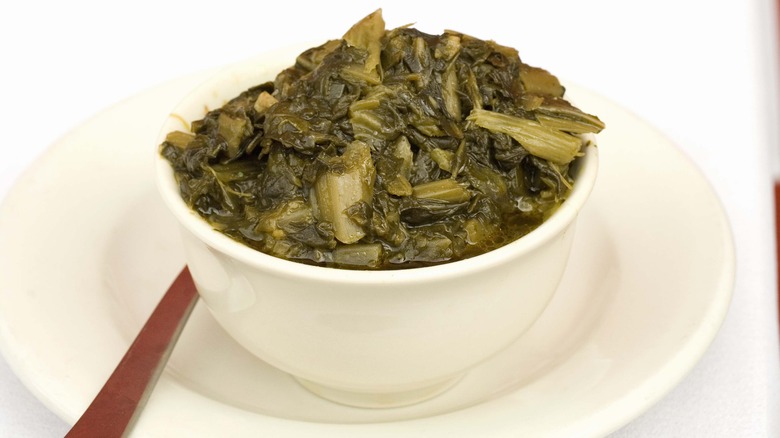New Year's Food Superstitions Around The World
It's no secret we'd all like to start the new year off with some good luck, longevity, prosperity, and health, but it may not be as easy to obtain those things as it is to count down the seconds until midnight. Rather than leave it up to chance, why not try some worldly traditions to increase your odds at a lucky year ahead — like eating long noodles, gifting an orange, devouring oliebollen, or choking down 12 grapes when the clock strikes 12 (via Smithsonian Magazine).
No one really knows where most of these superstitions come from, as it's hard to trace their cultural origins, but one thing every country around the world seems to agree on is that New Year's Eve foodie traditions lead to prosperity, health, good fortune, longevity, and love in the year ahead. If you're down on your luck this year or just need a reason to wash down some pickled herring with Champagne, check out this complete list of worldwide New Year's food superstitions.
Quickly eat 12 grapes in Spain for good luck
When the clock strikes midnight, people in Spain and around the world will be shoving 12 grapes in their mouth, making a wish with each grape and each gong of the bell. According to The Local, the New Year's Eve tradition dates back to 1882, when the mayor of Madrid, José Abascal y Carredano, imposed a tax on party goers, stating that anyone who celebrated well into the night would have to pay a fee. That meant that only the wealthy would truly be able to celebrate the holiday, as the working-class could not afford a tax on having a good time.
But that didn't stop them from an unruly New Year's party, and Madrid's working-class wound up staging a rebellion in front of the mayor's office. When the clock struck midnight, the crowd started eating grapes as a parody to the rich, who believed it to be classy to eat grapes when drinking Champagne. According to The Salt, people partaking in this tradition today should also wear red underwear as they do it and must finish all the grapes in a minute to receive good fortune.
If you don't buy that story, you may believe the tradition stems from scheming Spanish winemakers who wanted to get rid of their grapes, so they invented the wishful grape-eating tradition. Either way, the grape game is risky business and can be a choking hazard. If you're over 65 and want to live to see another New Year's, you may want to sit this tradition out.
Consume pickled herring in Germany and Sweden for money
Like most legends, it's hard to pinpoint where exactly pickled herring became a lucky delicacy at the stroke of midnight. As reported by Spectrum News 1 in Milwaukee, it's believed that an abundant catch of herring was good luck back in the day, as it meant you had enough fish to sustain you for some time since herring could be pickled and stored. One company based in northern Milwaukee carries on the Norwegian tradition, selling 60% of their hand-packed pickled herring stock in a few short months leading up to New Year's Eve.
In countries like Germany, Scandinavia, and Poland, the pickled fish is typically consumed at the stroke of midnight in the hopes of bringing prosperity and good luck for the year to come, according to The Takeout. While pickled fish may be an acquired taste for some, Norwegians think of it as a traditional holiday treat that is not only required but very much revered when it comes to ringing in the New Year.
Hoppin' John in the southern U.S. may help you find peace
Hoppin' John, also referred to as Happy Jack or Happy John, has been a New Year's Eve tradition in the southern U.S. since the 1800s, according to Almanac. It's a dish meant to invoke peace, prosperity, and luck in the New Year, in spite of its creation under far worse circumstances.
The recipe made its debut in an 1847 book titled "The Carolina Housewife," but History.com reports that enslaved people were making the dish long before it was published. The standard recipe includes black-eyed peas, cornbread, collard greens, tomatoes, and pork of some sort. The main lucky ingredient, black-eyed peas, is a bean that was introduced in American cuisine by enslaved West Africans, and it symbolizes wealth, hope, and luck in the New Year. Cornbread and collard greens also represent gold and money, respectively, while the pork serves as a symbolic reference to the low-quality meats fed to enslaved Africans, and tomatoes are a symbol of health.
No one really knows why the dish is named Hoppin' John or why it's associated with New Year's celebrations, but another interesting fact about this superstitious meal is that if saved for the next day and consumed as leftovers, it's called a Skippin' Jenny and it's even luckier.
Don't forget the lentils in Italy if you want prosperity
Since the time of Roman gods and gladiators, lentils have been considered a lucky food to eat, especially when ringing in a new year. According to Italian news source The Local, bowls or plates of lentils are handed out all over Italy just after the clock strikes 12, and everyone scarfs them down in the hopes of receiving luck and prosperity. It's a custom that has evolved since a time when Romans handed out lentils as gifts. When the coin-like legume is cooked, it starts to form a large and round shape that is equated with abundance.
Nowadays, lentils are usually sold out at markets across Italy days before New Year's Eve, so if you're traveling around the country for the holidays, be sure to grab them before it's too late. Like many other lucky dishes served on New Year's Day, lentils in Italy come with a side of cotechino sausage, which also has a deep-rooted history, dating back as far as ancient Egypt (via Web Food Culture).
Drink Champagne in Europe and America for status and fortune
Drinking Champagne on New Year's Eve is about as symbolic as a beverage and holiday combination can be. According to LiveScience, drinking the alcoholic beverage to celebrate special occasions dates back to the royal courts of Europe in the 1700s. Champagne was strictly consumed among royalty and the bourgeoisie, and was more so a symbol of status and wealth than luck.
The creation and introduction of Champagne into royal practice was not by chance of luck, as it took a lot of trial and error to get the bubbly beverage just right. Figuring out the right measurements of sugar and carbonation took chemists nearly 100 years to dial in, during which time there were explosions in the bottling process.
So, why not enjoy a little bubbly on New Year's Eve and hope it changes your luck? If you're serving Champagne on New Year's Eve, the trick is to chill it at a temperature of 46 degrees. To achieve this desired temp, experts recommend pulling the bottle out of the fridge for a half hour before popping the cork. This will bring out the more nuanced flavors of this classy beverage.
Slurp down soba noodles in Japan for health
Whether served hot or cold, made instant or handmade, and eaten at lunch, dinner, breakfast, or midnight, soba noodles are a lucky dish in Japan dating back to the 1700s, according to the podcast Uncanny Japan. Like most superstitions, the origins of why this dish is lucky and where it stems from are unclear, but the most widely accepted theory is that Japanese merchants would eat soba noodles at the end of the month and at the end of the year. Somehow they became a way to end either one with luck. Another theory suggests the high vitamin B1 quality in the noodles helps stave off disease and promote longevity, so that's why they're eaten on New Year's Eve or New Year's Day.
Made from buckwheat flour and water, soba noodles (also called Toshikoshi soba) are long, thin strands of noodles, and should not be cut short as the length serves as a symbol of resilience (via MasterClass). The texture is also softer than other noodles like udon or ramen, and is easier to bite off, which symbolizes "cutting off the bad luck of the year," as reported by Kodawari Times.
People around the world want to find coins in round cakes
Baked with either a symbol of a coin or an actual coin inside, a round cake is a New Year's Eve tradition around the world that's said to bring luck and money in the year ahead, according to The Atlantic. Practiced around the world from Greece to Scandinavia, the person who receives the slice with a coin or trinket hidden inside is the guest who will receive the most luck and prosperity, as reported in Smithsonian Magazine. The aromatic and rich cake will also typically have the year spelled out in almonds on top.
In Chinese New Year, a sticky rice cake — also called a nian gao, which means "year cake" — is a similar round cake served during New Year celebrations. In Scandinavia, their version of the lucky round cake involves rice pudding with a hidden almond inside. Scotland kicks it up a notch with round cake and whisky, and it's common practice in most cultures to serve the cake with Champagne.
Beans in Argentina are thought to bring job security
Of all the New Year's superstitions around the world, Argentina surely has some of the most interesting and long-standing customs compared to most everyone else. As noted in Elite Club, New Year's Eve is the most celebrated holiday in Argentina, and its traditions are rooted in Roman Catholicism.
According to Best Country, some of the most unique and bizarre traditions include running around the house on New Year's with a suitcase in the hopes it will instill exciting travel adventures in the year to come. Another oddball tradition includes swimming in pools, lakes, or rivers for good luck. Late dinners and loud fireworks are a more standard New Year's Eve custom in Argentina, and the dinner traditionally includes a giant bowl of beans.
The custom of eating beans in Argentina is believed to promote job safety and financial security, but if you're not into eating them, simply carry them in your pocket to generate more money, as the superstition goes.
Enjoy tamales in Mexico and hope for wealth
New Year's in Mexico may mean dinner at home with family and friends, partying at a public event in a city square, or dining at a nice restaurant along the beach. Fireworks, grapes, Champagne, and all-night celebrations are the norm when ringing in the New Year, according to Mexperience.
When it comes to food being served at home or dining out, there are some food items that can always be anticipated on a New Year's Eve menu. Tamales are a favorite dish throughout Mexico and are served at many holiday celebrations, festivals, and gatherings, according to the San Gabriel Valley Tribune, and they're a must-have dish for luck on New Year's Eve or New Year's Day. The golden color of the corn-based tamales also represents financial prosperity in the new year (via ABC News). It's no wonder that many vendors even sell out of tamales before the celebrations kick off.
Ward off an evil spirit with oliebollen in the Netherlands
You may not have heard of oliebollen, but on New Year's Eve, this deep-fried oil ball delicacy is devoured at gatherings and parties across the Netherlands, according to Dutch Review. A doughy, oily snack food that is served warm, oliebollen is typically topped with powdered sugar, raisins, currants, cinnamon and chunks of apple. It may also be dipped in caramel or chocolate sauce. It's traditionally paired with Champagne and enjoyed while watching fireworks or attending a bonfire made out of discarded Christmas trees (via Paste magazine).
In pagan tradition, oliebollen was consumed in order to ward off Perchta, a pagan goddess with a mean streak and an evil spirit, and thus eating oliebollen became a tradition. The first oliebollen ever consumed is unknown, but historians look to a 17th century painting that shows an oliebollen in a pot, proving it's been consumed in the Netherlands for a long time. In some parts of the country, fasting is a common practice in the weeks leading up to Christmas, and once completed, people would consume as much food and drink as they pleased, with oliebollen a common delicacy post-fast.
There are a few different superstitions regarding pork
If you eat pork, chances are you're going to be enjoying it on New Year's Eve regardless of where you are in the world, as many cultures ring in the New Year with some sort of pig on their plate, according to Smithsonian Magazine. In American history, having pork in your home meant you would be fed for months to come, which equates to longevity and abundance as far swine superstitions on New Year's Eve goes. Pennsylvania Dutch also pair their pork with sauerkraut because there's something special about pigs and cabbage that bring good luck in the new year, as reported by Times Union newspaper based out of Albany, New York.
Whole-roasted baby pigs are consumed on New Year's Eve in parts of the world, including Portugal, Spain, Hungary, and Cuba, and Italians and Germans ring in the new year with pork sausage on their plates. Gifting marzipan pigs is also a gesture of luck and good fortune in Germany, and tables are also decorated with mini marzipan pigs in place of a centerpiece (via Vice).
Gift oranges and tangerines in China for luck
Like most things round, oranges and tangerines are a symbol of prosperity in the new year, and they actually translate to success and luck in Chinese, as reported in The Jakarta Post. Bright orange-colored round fruits like oranges, tangerines, and kumquats represent gold and good luck, and are widely displayed, gifted, and eaten throughout China during their New Year's celebrations.
In other Asian cultures, pomelos are also commonly consumed at New Year's festivities and used as decoration, according to an article in The New York Times. Pomelos are particularly difficult to peel open, and eating or giving the sweet fruit away is part of Lunar New Year's traditions, though it's hard to trace the pomelo's history with the holidays.
These fruity delicacies are also given throughout the new year as an expression of love in many Asian communities, and are gifted as a whole fruit, a seed, or a plant. It may not seem like much to more expressive cultures, but it's a way to show someone you deeply care for them.
Pomegranate seeds mean different things in Greece and Israel
Of all the foods eaten and given for New Year's Day, pomegranates are arguably the most religious and holy. According to The Israel Bible, pomegranates are consumed on New Year's Day as a way to speak to God, telling him that just because you don't appear to have redeeming qualities on the outside, you have a good heart with good intentions on the inside, just like the pomegranate. The pomegranate seeds are a symbol of all the good within someone, and the more seeds you have inside your pomegranate on New Year's, the more good deeds you'll have within you. Another unique symbol of the pomegranate in Israel history is the six-pointed star found at the stem of the fruit, which represents the star of David and is the only food found in nature to bare this symbol.
In Greece, the pomegranate is still akin with the Gods, but is a symbol of luck in fertility and marriage and is often smashed on New Year's Eve. The more seeds that fly from the pomegranate upon smashing it, the better luck your household will have in the year to come.
Eat collard greens in the southern U.S. for wealth
Grown predominantly in the southern United States, collard greens are a popular side dish year-round, and are particularly lucky when consumed as part of a New Year's Eve dinner. The bright leafy green is thought to be a symbol of wealth and money, and superstition has it that eating collard greens on New Year's Eve will bring great prosperity in the year to come, according to About Little Rock. Collard greens are often served with pork and black-eyed peas, which are both part of New Year's Eve traditions in the south as well (via The New York Times).
It's not just a superstition based on its green color, as it's also believed that folded collard greens resemble the look and feel of money, and their shape is just as important as their prosperous color. Originating in Northern Europe, this tradition was then passed on to Africans during the European slave trade, after which it made it's way to the U.S. Collard greens may have a muddy history, but eating them on New Year's Eve may just lead to a brighter future.
